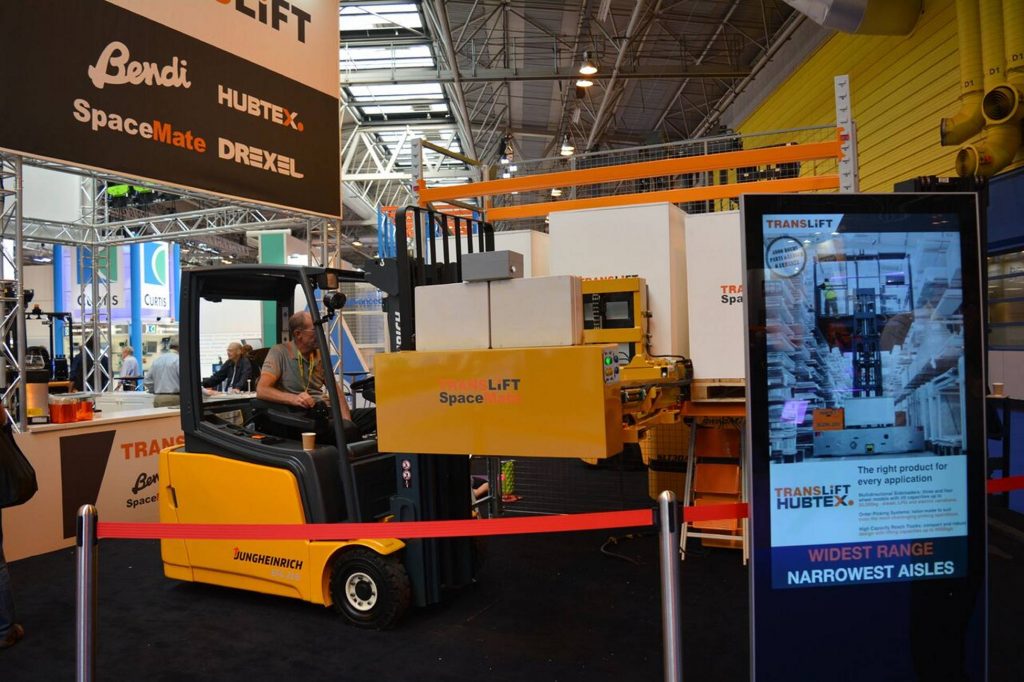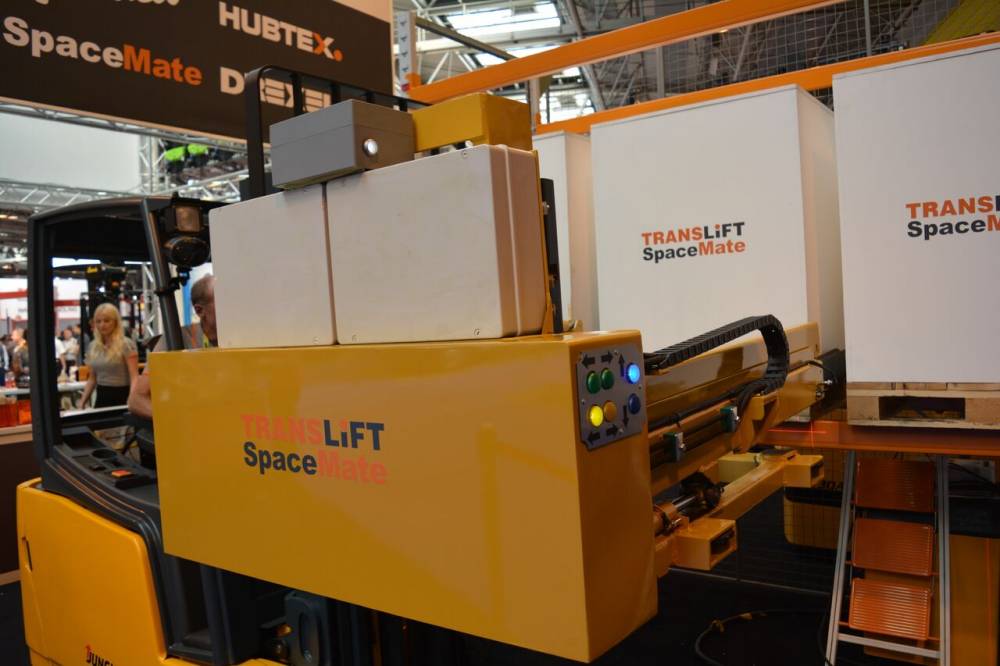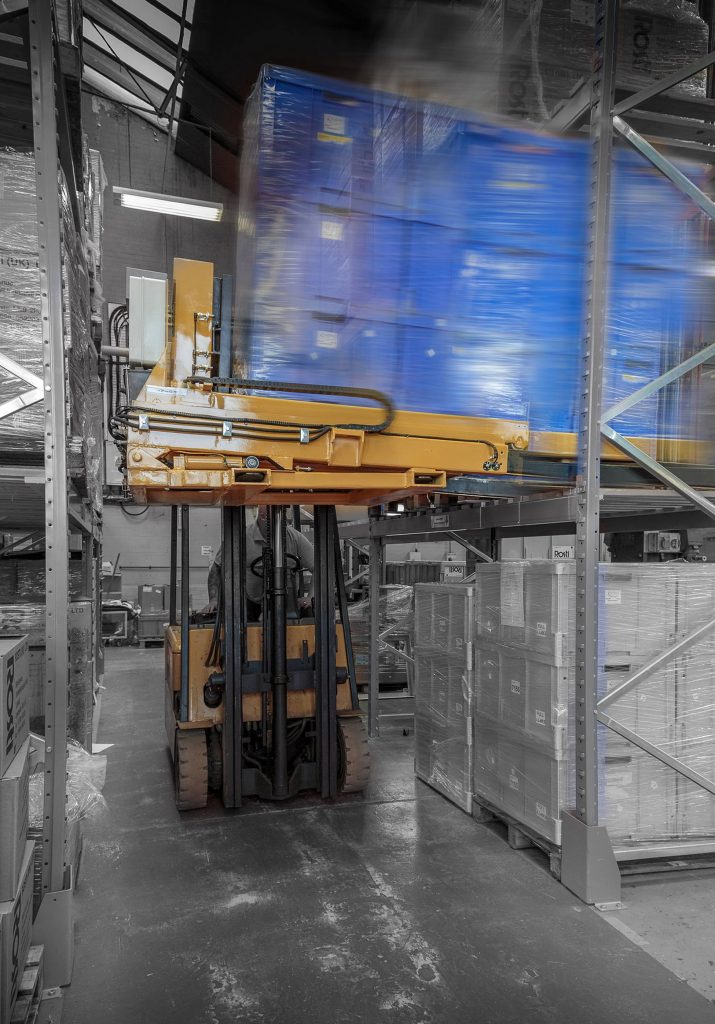Launched at IMHX 2016 to great acclaim, the new SpaceMate fork lift truck attachment from Translift Bendi promises to reduce aisle widths to 1,800mm for a fraction of the cost of an articulated or VNA truck. Claiming it as “unique”, Translift MD Simon Brown explains the thinking behind this potentially revolutionary piece of equipment.
What is the new SpaceMate?
The SpaceMate is the concept of creating a temporary bridge from the lifting device/forklift to the racking without the lifting device’s sideways stability being compromised. At the moment it’s an attachment that fits any forklift with no modification to the truck.
What does this mean to customers?
Customers who have an existing forklift could use a SpaceMate to reduce aisle size to 1800mm. This would be at 1/3rd of the cost of an Articulated truck, or 1/5th of a conventional VNA truck.
Why would a customer buy one of these instead of articulated or conventional VNA?
I think the SpaceMate would be bought as well as a conventional VNA truck or Articulated truck to provide additional resource during busy periods at a fraction of the cost of an additional machine. The SpaceMate would allow conventional forklifts to provide backup in the narrow aisles.
Does this kill off the articulated market?
Not at all, it compliments it. Many potential users are put off narrowing their racking aisles by the perceived high initial cost of an articulated truck. The SpaceMate gives those users an entry level solution. Additionally, some users who can only afford one narrow aisle machine may feel too vulnerable to depend on one machine and stay with reach or counterbalance trucks. Now they could have a standby SpaceMate taking up one pallet position in the racking in case of breakdowns or busy periods at 30% of the cost. This low cost also lowers the entry threshold in terms of financial justification so the SpaceMate will appeal to a wider market.
Is this just for end users?
No, Forklift manufacturers and dealers of VNA equipment now have a low cost “off the shelf VNA solution” and the SpaceMate has been designed to fit in the back of a service van for easy delivery to customers. We designed the SpaceMate with the dealer very much in mind. Many more applications will be spotted by an industry professional aware that there is a new solution available. The SpaceMate can be fitted out in the field by a service engineer without any specialist training, or even the end user with the bare minimum of training.
How exactly does it work?
The principle is very simple: Lasers similar to supermarket scanners are used to visually position the forklift in the ideal spot. The trucks side shift function is used to extend two bridge arms out of the SpaceMate into the pallet racking either side of the pallet location. The arms are tilted down slightly and placed anywhere from 2-700 mm above the racking beam. The arms are lowered until they rest with four points in contact with the racking. This is where the device creates a stable “bridge” between the four points of the two forks and the two racking beams.
This “bridge” position activates the fork carriage allowing it to travel out in between the bridge arms and lower the pallet into position onto the racking beams and then return to its start position. The bridge arms are then tilted upwards off the rack beams and then retract back into the main body.
How does this affect the side shift?
We supply a quick release block with the machine. This connects the SpaceMate to the hydraulic supply and also safely locks off the sideshift.
Can it be fitted to a Gas or Diesel forklift?
Yes, the electrical requirement of the SpaceMate is provided by a rechargeable battery. So, the electrical supply from the truck is not required.
What if the arms are not level?
The SpaceMate has switches in the bridge arms that will only allow the carriage to travel across the bridge if it can see four points of contact on the racking beams.
Will it damage the racking and what do racking suppliers think?
No, in fact, we consulted with SEMA experts who advise on the safety standards for pallet racking and storage, early in the development. We took their advice and we built safety features into the SpaceMate’s function accordingly. We believe that the SpaceMate will be far safer than conventional trucks in a number of areas: where the forks can put pressure on the rack beams when over lowered, or where the trucks can drive into upright sections or can bend beams due to incorrect height selection. The SpaceMate has the innate height selection feature: As the operator extends the bridge arms at any height above the beam its far easier to see from ground level making the SpaceMate much safer than conventional trucks that have only 100mm tolerance to enter a pallet.
What are the truck requirements for the SpaceMate to work?
Very little, the SpaceMate will fit on to any counterbalance, reach truck, man up order picker, support arm stacker, Boom lift or even a JCB. The only requirement is that it has a hydraulic feed.
What height can it lift to and how easy is it at height?
The SpaceMate attachment is not limited in height. In fact, it’s easier to use at height than conventional forklifts as height selection is designed out of this system.
How much does it weigh and how much can it lift?
The SpaceMate currently weighs 450kg so a1500kg truck with sideshift will lift 1050kg, as would a 1500kg support arm stacker. We plan to reduce the SpaceMate weight to increase residual capacity.
It’s almost as automated as a little robot, why is this?
Because we wanted it to be fitted to any truck, any where, and by anybody, we’ve simplified the interface down to two quick release couplings. To allow this we have sequenced all the hydraulic functions through a simple processor and its become more of a simple mini robot than just a hydraulic attachment.
Is it just an attachment or is it an entirely new concept?
It’s an entirely new concept that can be applied to many more applications than just an attachment. For example, a turret head VNA has a lot of weight in its chassis to keep it stable and rigid whilst the load is reached out at height. If the turret concept of the 1950’s was replaced with the SpaceMate concept a much lighter and cheaper chassis, similar to a high level order picker, could achieve the same capacity at height.
Would you go back to building VNA machines?
No, however we would be interested in co-operating with any VNA truck manufacturers that wanted to explore the concept with us.
What other applications do you see for the SpaceMate?
Regulations dictate that items over 25kg are not to be manually handled, so often we see single bulky parts like a forklift drive motor or gearbox on pallets that can’t be stored in a shelving system and they take up an entire pallet location. The SpaceMate concept could be reduced down in size to allow items of 25kg upwards to be stored in shelving only a few hundred mm wide required for pedestrian access.
What are the training requirements?
The training is similar in depth and duration as for any other multi function attachment. For the UK a single day is required.
Is it slower than conventional Articulated or VNA?
This was our fear too, but after only a few cycles it becomes easier to use than conventional trucks and in a much shorter learning period. We were quickly stacking as quickly as an Articulated forklift and were able to improve on the volume of pallets stored by Reach or VNA trucks.
It looks complicated?
From an observer’s point, yes it does, but because all the thinking is done in the sequenced program. From an operator’s point of view its very simple to use, just the lift and tilt functions – that’s it. Mechanically its simple too. We wanted to make sure the SpaceMate could be used and maintained in all corners of the world so virtually everything is available off the shelf around the world.
Has anything like this been done before?
No, it’s unique as far as we know – nothing else has ever stacked a pallet in this manner before which has enabled us to get a very strong patent on the principle.
Where do you see the sales for this SpaceMate?
Everywhere, and the more people I talk to about the SpaceMate the more people become excited and tell me where they could use it.
Here are some examples:
Archive storage, farm produce, tyre storage in stillages, manufacturing line-side storage. VNA breakdown support, rental fleets, building sites on boom trucks, heavy parts shelving, the natural progression of the VNA market as the turret head replacement – the list goes on.
View the article here: flickread.com/edition/html/index.php?pdf=581090443a736#48
For more information please contact us here or call 01527 527 411.



